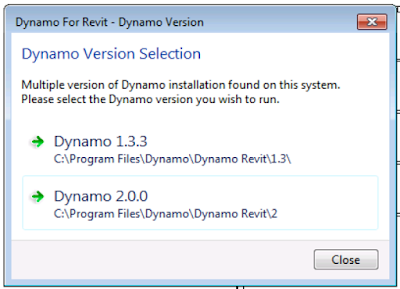Dynamo Versions
The latest versions of Dynamo do not support Revit 2016.Refer to DynamoBIM blog
The theory behind this is that the Autodesk Dynamo team are working to a system whereby only three consecutive annual releases need to be supported by any version (2016, 2017, 2018 or 2017, 2018, 2019). Typically Autodesk Revit licenses are set up that way, to only allow 3 years - but its only a license issue, not an inbuilt Revit limitation. However, Autodesk realise that in the real world it is very difficult to manage a Revit installation in a company where you have multiple projects that need to be on different Revit versions to match up with varied consultants on each project. Supporting 4 versions of Revit simultaneously is quite common in the industry - and Autodesk will supply licenses for this accordingly if you ask them (or your reseller).
There are two new Dynamo versions available:
- Dynamo 1.3.3 which is virtually the same as 1.3.2, except in the versions it supports
Dynamo 1.3.2 supports Revit 2016, 2017 & 2018 (but not 2019)
Dynamo 1.3.3 supports Revit 2017, 2018 & 2019 - Dynamo 2.0 is a whole new 'Major Release' - it is not backward-compatible with previous versions (dyn and dyf files are saved in a new format)
Dynamo 2.0 supports Revit 2017, 2018 & 2019
Dynamo 2.0 graphs and custom nodes cannot be opened in 1.xx versions. Some or most Dynamo 1.xx graphs and nodes will work in Dynamo 2.0 but there is no guarantee - see DynamoBIM Blog 2.0 and Beyond for more detail.
It is possible to have two parallel installations of Dynamo 1.3.2 (or earlier) and 2.0 - both of which would run on Revit 2017 & 2018 (you get a choice of which to run when you start Dynamo) - but only one of those two versions would run on either Revit 2016 or 2019 (unless you have 1.3.3 and 2.0 which could both run on 2019).
I don't think that you can have both 1.3.2 and 1.3.3 running in parallel like this - I have not tried it, but that is the word I see on forums. I believe that one install messes up the other - and you can't choose which versions of Revit to install Dynamo to.
If you do want to have two versions of Dynamo installed (one being 2.0), you will need to maintain two versions of all your graphs, custom nodes and packages. And don't get them mixed up!
If you have any projects still in v2016, you will need to consider very carefully how you handle your Dynamo versions. I would personally recommend that you hold off Dynamo 2.0 until you are quite certain you won't ever need to do anything in Dynamo in Revit 2016 - once you make that leap to 2.0 there is no going back.
It would be really helpful for us if Autodesk were to give us a version of Dynamo (1.xx) that is just like 1.3.3 but supports Revit 2016 too (ie. 4 consecutive Revit versions). I believe there is no technical reason why not - its just a decision making process at Autodesk. That would help us get over this tricky version management situation until things have moved on a bit - then we can all stop using Revit 2016 and the Dynamo 1.xx series, in our own good time, and move on to 2.xx series Dynamo. Happy ever after. Until the next major release, that is!
Dynamo & Revit 2019 Install
Last year the Revit 2018 installation automatically installed quite a several month old version of Dynamo - which caused all kinds of issues for people who already had newer versions. For 2019, Autodesk have gone to the opposite extreme: the latest build of Dynamo was automatically installed: 1.3.3 with Revit 2019. But of course it automatically removes old versions of Dynamo in the process - without any warning whatsoever.When I fired up Revit 2016 after installing 2019, I could not find Dynamo. The Revit 2019/Dynamo 1.3.3 installer had uninstalled it completely from 2016.
Prevention is Better Than Cure - a Dodgy 2016 Workaround
If you still need 2016, you should protect your older Dynamo install for Revit 2016 before you do the Revit 2019 install. I tried this rather dodgy workaround - from what I read on the DynamoBIM forums:Make copies of these files (assuming Dynamo 1.2 but just substitute 1.3.2 if that is your version):
- Dynamo.addin file in the C:\ProgramData\Autodesk\Revit\Addins\2016 folder
- These two folders:
C:Program Files\Dynamo\Dynamo Core\1.2
C:Program Files\Dynamo\Dynamo Revit\1.2\Revit_2016
In my case, it was too late - I had already installed Revit 2019, so I found a Dynamo 1.2 installation on another computer and copied those files to the computer where they had gone missing - to my surprise it actually worked.
Warning: be very careful messing around with deleting/copying files and folders in your Program Files directory - do this at your own risk.



No comments:
Post a Comment